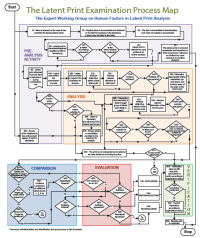Fingerprint analysis is critical to the success of the nation's criminal justice system. In fact, fingerprints left at a crime scene — referred to as latent prints — are the most common type of forensic science evidence and have been used in criminal investigations for more than 100 years.
The examination of fingerprint evidence consists of a series of steps involving the comparison of latent print to a known print (called an 'exemplar'). During this step-by-step matching process, latent print examiners must reach correct conclusions; they are also expected to produce records of the examination and, in some cases, present their conclusions — and the reasoning behind them — in court.
In recent years, the accuracy of latent print identification has been the subject of increased scrutiny, including from the National Academy of Sciences in their 2009 report, Strengthening Forensic Science in the United States: A Path Forward (pdf, 350 pages). To help address this issue, the National Institute of Justice and the U.S. National Institute of Standards and Technology (NIST) convened an expert working group to do a scientific assessment of the effects of human factors on forensic latent print analysis and to develop recommendations to reduce the risk of error.
The working group addressed issues ranging from the acquisition of impressions of friction ridge skin to courtroom testimony, and from laboratory design and equipment to emerging methods for associating latent prints with exemplars. In addition to a comprehensive discussion of how human factors relate to all aspects of latent print examinations — including communicating conclusions through reports and testimony — the report offers specific recommendations to improve the understanding and management of human-factors issues in fingerprint analysis.
Creating a Culture of Openness Among Examiners
The working group made a number of important recommendations that touch on everything from the time latent prints are submitted for examination to testimony in the courtroom. Among the recommendations is the need "to create a culture in which both management and staff understand that openness about errors is not necessarily a path to punitive sanctions but rather is part of an effective system to detect deviations from desired practices and incorrect judgments in latent print casework."
To help achieve such a culture, the panel recommended that management in forensic crime laboratories:
- Employ a system to identify and track errors and their causes.
- Establish policies and procedures for case review and conflict resolution, corrective action, and preventive measures.
Flowchart of Analysis, Comparison, Evaluation and Verification
One particularly helpful tool in the report is a flow chart that shows the Analysis, Comparison, Evaluation and Verification (ACE-V) process for latent print examination that is currently used in the nation's forensic crime laboratories. This chart, developed by the working group, offers a detailed view of steps in the ACE-V process where human error risks should be minimized.
This flowchart provides a valuable reminder of each step in the ACE-V process.
See Chapter 1: The Latent Print Examination Process and Terminology for a detailed description of steps within the process.
Research and Development Recommendations
The working group also identified a "critical need" for research into the interpretive process that is at the heart of the ACE-V process. "For example," they said, "only a handful of studies have assessed variation in the feature selection process. Generally, the findings have shown wide variation among examiners during the task of feature selection."
Other areas where research is recommended include:
- Determining the educational and cognitive abilities that should be prerequisites for training a latent print examiner.
- Developing methods that reduce the variation of the print features selected for comparisons.
- Developing a better understanding of the link between variations in feature selection and the examiner's ultimate determination.
- Addressing the utility/sufficiency of latent print analysis.
- Developing measures/metrics for latent print analysis — and using these to assess the reproducibility, reliability and validity of various interpretive stages of the process.
- Identifying key factors related to variations in the performance of latent print examiners during the interpretation process.
- Creating large, anonymous databases of exemplars and latent prints to facilitate the validation of probabilistic models and other statistical research.
- Determining the most appropriate tests of visual function for friction ridge examiners.
In particular, the working group said that the federal government should support research programs to improve automated fingerprint identification systems. Such programs could, for example:
- Expand the algorithms used to match prints to account for the fact that the diagnostic value of minutiae depends on the region in which they are located.
- Make fingerprint and palm print databases interoperable among local, state and federal automated identification systems.
- Increase the compatibility between automated identification systems and other latent print software tools, including digital enhancement programs, probability calculation programs, and automated quality assessment programs.


